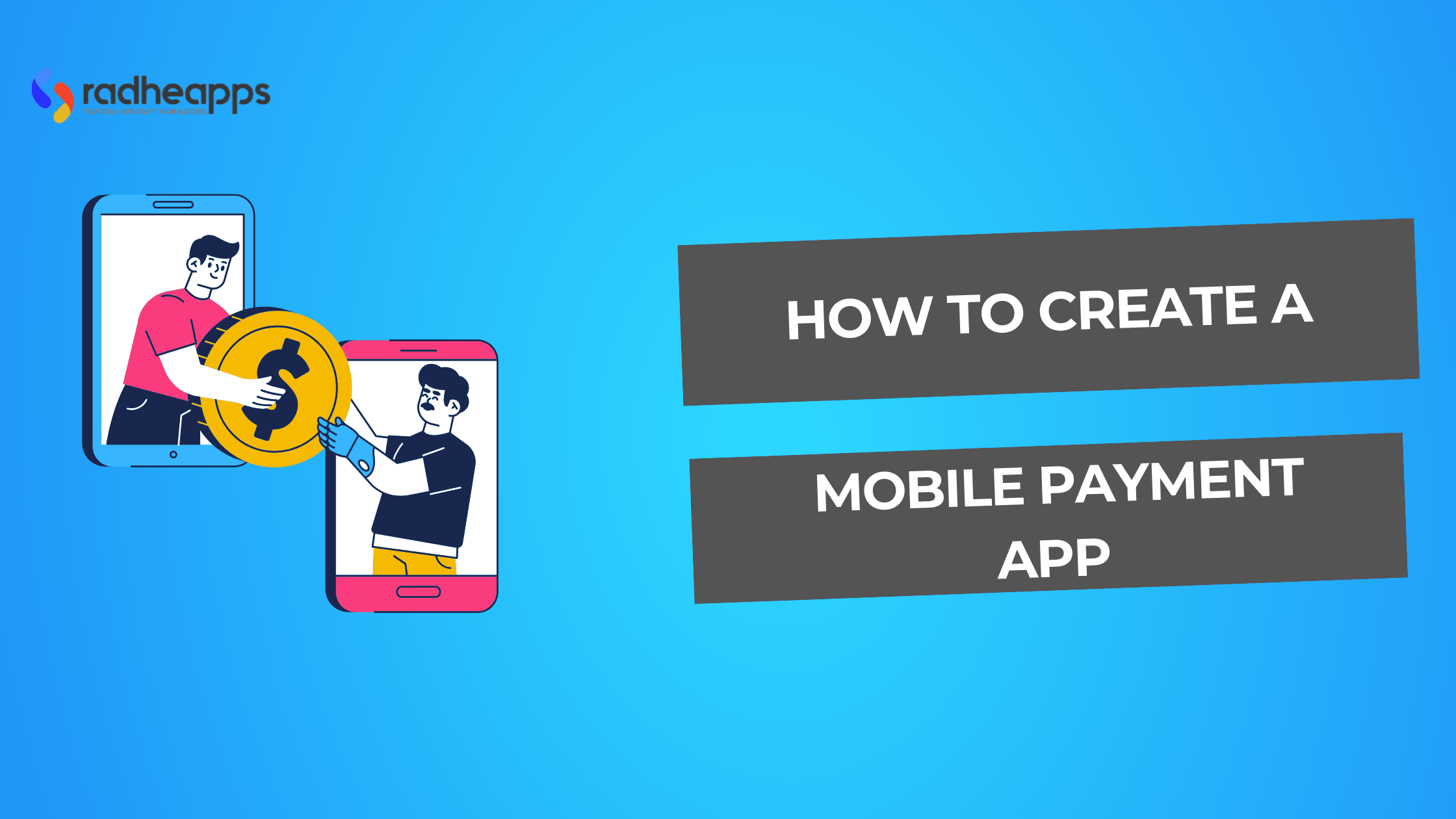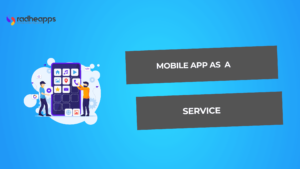As the mobile payment apps have transformed the payment method, the days of cash handling anywhere or long queues waiting have gone. These mobile payment apps have changed how we pay and receive money securely and efficiently.
Mobile payments have quickly become a part of daily life, whether online shopping, bill splits with friends, or paying for coffee online. They are more than convenient for businesses, as they can implement faster checkout and provide multiple payment options with high-end security.
These apps improve customer satisfaction and increase sales. Proper mobile payment will add value to your business and keep you competitive in the digital economy. But creating an efficient mobile payment app isn’t just a piece of cake. It requires foolproof strategies, experts’ guidance, and a team of developers.
The question is, how will you find everything at once? We are the answer.
At Radheapps, we offer custom mobile payment app building solutions that help you grow your business. Whether you need an in-store point-of-sale payment system, an online payment or checkout method, or an integrated secure peer-to-peer money transfer app, we can help.
We build scalable, high-performance payment platforms that comply with all necessary regulations while providing speed and security. We can help you create a future-proof, simple-to-use, secure mobile payment app solution to give your business a competitive advantage.
Consult us to get started on your custom mobile payment solution!
Or
If you’re ready to take your payment experience to the next level, contact Radheapps today!
What are Mobile Payment Apps?
Mobile payment apps are digital platforms that allow users to make payments using their smartphones. They reduce the use of physical cash and leverage NFC, QR codes, and online banking. Some popular apps are PayTM, Apple Pay, and Google Pay. They facilitate secure and seamless transactions.
How Mobile Payments are Transforming Commerce
The increasing use of mobile payment apps has revolutionized how businesses and consumers interact. From offline markets to e-stores, mobile payments have conveniently enhanced secure online transactions.
Digital payments reduce dependency on cash and allow faster contactless payments, which is beneficial for financial management.
Key Benefits for Businesses and Consumers
For Businesses
- Faster Contactless Payments: These apps increase efficiency and reduce checkout time.
- Reduce Costs: Businesses can eliminate physical cash handling charges by increasing online transactions.
- Enhanced Customer Experience: Online payment apps enhance convenience with quick, contactless payment options.
- Secured and Encrypted: 2-step encryption and secure transactions ensure safer payments.
For Consumers
- Convenience: No need to carry cash every time.
- Speed: This allows you to transfer money quickly and hassle-free.
- Security: Improved security encryption and biometric authentication reduce the risk of cyber attacks.
- Expense Tracking: User can easily track their daily or weekly expenses through the app.
- Global Accessibility: Enables seamless international transactions without currency exchange issues.
Popular Types of Mobile Payment Solutions
| Type | Description | Examples |
| Mobile Wallets | Digital wallets that store cash for quick and easy transactions. | Amazon Pay, PayTM, or Samsung Pay |
| Peer-to-Peer (P2P) Payments | Apps that allow users to transfer money directly worldwide. | PayPal |
| QR Code Payments | Provide QR codes for a secure and faster payment transaction. | Google Pay, Paytm, or Amazon Pay |
| Contactless NFC Payments | It uses near-field communication for easy tap-and-pay transactions. | Apple Pay, Samsung Pay |
| Bank-Based Mobile Payments | Direct transfers linked to bank accounts. | BHIM UPI (India),
PayNow (Singapore) |
Essential Features of a Mobile Payment App
A well-structured mobile payment app must have high-end security features, flexibility, and the ability to provide seamless money transactions. Here are some key features that make a mobile payment app reliable:
Secure Payment Processing
- Implement End-to-End Encryption: Encrypt transaction data for end users to prevent unauthorized access. Secure sensitive user information with AES (Advanced Encryption Standard) and RSA encryption protocols.
- Compliance with PCI-DSS and Other Security Standards: Adheres to the Payment Card Industry Data Security Standard (PCI-DSS) to protect user transaction card details. A reliable app should meet GDPR, ISO 27001, and other relevant regulations to ensure data privacy and security.
Multiple Payment Methods
- Credit and Debit Card Integration: These apps support transactions from all major cards, such as Visa, Mastercard, and American Express. Tokenizations store card details securely for future use.
- Digital Wallets and UPI Support: These apps are already integrated with digital wallets like Apple Pay, Google Pay, and Samsung Pay for easy transactions and allow UPI for instant bank transfers.
- Cryptocurrency and Alternative Payments: These apps also allow transactions using Bitcoin, Ethereum, and other cryptocurrencies and support Buy Now, Pay Later options for flexible payments.
User Authentication and Fraud Prevention
Robust authentication ensures that only authorized users can access their data.
- Biometric Authentication (Face ID, fingerprint): Facial recognition, fingerprint scanning, and iris detection provide a secure and convenient login process that reduces the risk of password theft or unauthorized access.
- AI-driven Fraud Detection and Risk Management: These apps can analyze user behavior and detect security breaches by implementing machine learning algorithms. They use real-time monitoring to flag suspicious activities and help prevent fraud.
How to Develop a Mobile Payment App
Follow these key steps to develop a mobile payment application infrastructure.
Define the App’s Purpose and Target Audience
Start by identifying your target users, such as businesses or individuals. This will help you structure the app’s core features, which include QR code, NFC, or trading transactions. Design it by focusing on the needs of online shopping, retail payments, or international money transactions.
Choose the Right Technology Stack
The choice of suitable programming languages and frameworks provides the best outcomes.
Frontend
- Language for iOS Development: Check for coding language Swift, Objective-C or other best iOS development tools.
- Language for Android Development: Kotlin or Java.
- Better Cross-Platform Support: Learn how React Native or Flutter are good for app development.
Backend
- Frameworks: Node.js, Django, Ruby on Rails.
- Database: PostgreSQL, MongoDB, or Firebase.
- Cloud Hosting: AWS, Google Cloud, Microsoft Azure.
Integrate a Secure Payment Gateway
A reliable payment gateway is essential for smooth and secure transactions. Popular options include:
| Payment Gateway | Features |
| Stripe | It supports global payments, has strong security, and is easy to integrate into APIs. |
| PayPal | Trusted worldwide, ideal for e-commerce, supports multiple currencies. |
| Square | Best for small businesses, POS integration, and fast settlements. |
| Razorpay | Indian payment gateway with UPI, net banking, and card support. |
Design a User-Friendly and Responsive Interface
A seamless UI/UX ensures better user engagement and faster transactions.
- Simple Navigation: Minimal steps to complete payments.
- One-Click Payments: Store payment methods and history for quick checkouts afterward.
- Multi-Language & Multi-Currency Support: Essential for global reach.
Develop the Backend for Seamless Transactions
A robust backend is crucial for seamless and secure transactions. Implement API-based transactions to connect with banks and financial services. Securely store transaction history in encrypted databases.
Test for Security, Performance, and Usability
Penetration, load, and usability testing are vital to ensure that the app works correctly and has enhanced security features. These tests identify security loopholes and provide a better UI for a seamless user experience.
Launch and Continuously Update the App
Once the app is ready, deploy it on Google Play Store, Apple App Store, or private enterprise networks.
- Monitor app performance and resolve bugs quickly.
- Roll out regular security updates to comply with PCI-DSS and GDPR.
- Introduce new features like AI-driven fraud detection and voice payments.
How to Choose the Right Payment Gateway for Your App
The right payment gateway ensures a seamless, secure, and efficient transaction experience. Consider these factors before selecting a payment app.
Compare Stripe, PayPal, and Square
| Feature | Stripe | PayPal | Square |
| Best For | Online businesses, SaaS, and e-commerce | Small businesses, freelancers, and global transactions | Small companies and POS systems |
| Transaction Fees | 2.9% + 30¢ per transaction (varies by country) | 2.99% + fixed fee (varies by currency) | 2.6% + 10¢ per tap, dip, or swipe |
| Global Reach | Supports 135+ currencies in 47+ countries | Available in 200+ countries | Primarily the US, Canada, Australia, the UK, and Japan |
| Security Features | PCI-DSS compliant, AI fraud detection, encryption | Buyer and seller protection, encryption | End-to-end encryption, fraud monitoring |
| Payment Methods | Credit/debit cards, digital wallets, ACH, crypto (beta) | Credit/debit cards, PayPal balance, digital wallets | Credit/debit cards, Apple Pay, Google Pay |
| Integration | Developer-friendly API, customizable checkout | Easy setup, plug-and-play for websites | Seamless POS system integration |
Factors to Consider: Transaction Fees, Security, and Global Reach
Transaction Fees
- Analyze per-transaction costs, monthly fees, and hidden charges.
- Stripe and Square offer competitive rates for businesses.
- PayPal is accepted worldwide but may have higher fees.
Security
- Verify PCI-DSS compliance and security protocols to protect transactions.
- Look for fraud detection features like risk assessment and transaction protection.
Global Reach
- Choose a gateway that supports multiple currencies and countries if you have global transactions.
- PayPal has the broadest reach, while Stripe excels in handling diverse currency options.
Compliance and Regulatory Requirements
A mobile payment app must comply with financial regulations to operate legally and securely. This is crucial for protecting businesses from legal risks and increasing user trust.
GDPR, PSD2, and Other Legal Considerations
Let’s understand how legal considerations work:
GDPR
The GDPR, which applies in the European Union (EU), mandates strict data privacy and security measures. It requires businesses to obtain explicit user consent before collecting personal and financial data and ensures users have the right to access, modify, or delete their data.
PSD2
Enforced in the EU and EEA, PSD2 improves online banking security. It implements Strong Customer Authentication for electronic payments and promotes online banking. It enables third-party financial service providers to access customer data securely via APIs.
Other Global Regulations
- CCPA (California Consumer Privacy Act): It is similar to GDPR but applies to businesses operating in California, USA.
- Reserve Bank of India (RBI) Guidelines: The RBI guidelines set data localization and security requirements for payment apps in India.
- PCI-DSS: A global security standard for handling credit card transactions securely.
Ensure KYC (Know Your Customer) and AML (Anti-Money Laundering) Compliance
- Know Your Customer (KYC): KYC verifies user identities before processing transactions, which includes a verification method through government-issued IDs, biometric checks, and address verification.
- Anti-Money Laundering (AML): AML laws prevent financial crimes like money laundering. This monitors transactions for suspicious activities and reports them to regulatory authorities.
Cost of Developing a Mobile Payment App
Here’s a deep insight into the Cost of developing a Mobile Payment App:
Breakdown of Development Costs
| Cost Component | Estimated Cost Range | Description |
| UI/UX Design | $5,000 – $20,000 | For an intuitive and user-friendly interface. |
| Backend Development | $15,000 – $50,000 | For a secure and scalable framework. |
| Mobile App Development | $20,000 – $100,000+ | For Android and iOS applications with payment processing. |
| API Integrations | $5,000 – $30,000 | Integrated payment gateways, banking APIs, and third-party services. |
| Security & Compliance | $10,000 – $50,000 | Implementation of proper PCI-DSS, GDPR, and fraud prevention mechanisms. |
| Testing & QA | $5,000 – $20,000 | These tests are prior to ensure app performance, security, and bug-free transactions. |
| Maintenance & Updates | $5,000 – $15,000/year | For future app improvements, security patches, and feature enhancements. |
Total estimated cost ranges from $60,000 – $250,000+, varying on complexity, features, and security requirements.
Factors Influencing the Budget
- App Complexity & Features: A basic payment app with P2P transfers costs less than a fully featured application with fraud detection and biometric authentication.
- Development Team & Location: North American or Western European developers cost more than outsourcing to India or Eastern Europe. In-house teams or freelancers ensure better quality and flexibility.
- Security & Compliance Requirements: Compliance with security regulations including PCI-DSS, GDPR, and PSD2, is costly but is essential for protecting the banking system.
- Third-Party Integrations: Stripe, PayPal, and Square charge transaction fees on every transaction.
How to Reduce Expenses Without Compromising Security
- Use Pre-Built Payment Apps: Rather than building a custom gateway, integrate solutions like Stripe, Braintree, or Razorpay to save time and costs.
- Start with an MVP: Focus on essential features like basic payments and authentication before adding advanced capabilities.
- Outsource Development Team: Hire an experienced app development team for the backend.
- Leverage Open-Source Solutions: Use secure open-source frameworks for authentication and encryption to increase transaction reliability.
- Implement Cloud-Based Infrastructure: Opt for AWS or Google Cloud to lower infrastructure costs and scalability.
Future Trends in Mobile Payment Apps
Advancements in AI, blockchain, and contactless technology are the key trends of the future of digital payments. Let’s learn about those:
AI and Machine Learning for Personalized Payments
Artificial Intelligence (AI) and Machine Learning (ML) have improved the online money transfer experience by making transactions faster and more secure. These features help identify suspicious activities by analyzing spending patterns. AI suggests preferred payment methods based on user habits.
Features such as virtual assistants like Alexa, Siri, and Google Assistant provide seamless voice-enabled transactions.
The Rise of Contactless and NFC-Based Payments
Near-field communication (NFC) and contactless payments have become popular for quick transactions. A simple tap-to-pay feature reduces checkout times and supports Apple and Samsung wearable devices.
Metro cities are quickly adopting NFC-based buses, subways, and train ticketing. These systems are highly secure and feature features like face or fingerprint authentication.
Blockchain Technology in Financial Transactions
Blockchain revolutionizes the payments industry by providing decentralized, secure, and transparent transactions. It also helps reduce transaction costs and processing times for global payments. Blockchain enables conditional payments that execute automatically when preset conditions are met.
Conclusion
Fast transactions through mobile payment apps are no longer just a trend—they’re a requirement of our daily lives. Integrated with AI fraud detection, contactless NFC payments, and blockchain-secured payments. This advancement of digital payments brings growth opportunities for businesses and consumers.
A secure and frictionless mobile payment solution is not about convenience for businesses. It is about improving customers’ experience, sales growth, and being ahead of the competition.
But sometimes, the complexity of payment gateways, compliance, and security options can overwhelm people when choosing the right payment solution. That’s where Radheapps comes in!
Our expert team delivers custom high-grade mobile payment apps that are fast, secure, and capable of scaling. The custom solutions we build support your digital wallet launch, or improve your e-commerce checkout experience or integrate contactless payments.
These will all lead your business to growth and customer loyalty. Don’t let outdated payment systems slow your business down!
Contact Radheapps today to create a secure, user-friendly, and future-ready mobile payment app! Reach out to begin working on the next big thing in digital payments!
Frequently Asked Questions (FAQs):
How Long does it Take to Develop a Mobile Payment App?
A mobile payment app development usually takes 6 to 12 months, based on testing, team size, features, and complexity are some of the factors.
What is the Best Payment Gateway for Mobile Apps?
Stripe, PayPal, Razorpay, and Cashfree are popular and well-regarded options with diverse features, easy integration, and strong security, especially for Indian businesses.
How Can I Ensure my Payment App is Secure?
To ensure the security of your payment app, use strong, unique passwords, enable two-factor authentication (2FA), and keep your app and device software updated.
What are the Biggest Challenges in Mobile Payment App Development?
The biggest mobile payment app development challenges include ensuring robust security and data privacy, navigating complex regulations, building user trust, and achieving seamless user experience (UX).




